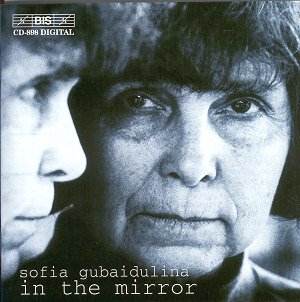BIS have done much to put Sofia Gubaidulina’s music
before a wider public, as a brief glance at their discography of her
music shows. Here we have another recording revealing the depth of thought
her music can offer. The principal interest here is in the contrast
between what is only Gubaidulina’s second acknowledged work, the 1957
Piano Quintet and two later works written respectively twenty-one
and thirty-five years later.
Not surprisingly for a Soviet-born composer who grew
up in the forties and fifties, the influence of Shostakovich on her
early music can be seen as unavoidable although it soon becomes clear
that Prokofiev is also present, albeit to a lesser degree. Gubaidulina
graduated in composition following studies at the Moscow Conservatory
with Nikolai Peiko, Shostakovich’s assistant, so the contact would indeed
have been close. In the Quintet’s opening Allegro the spirit
of Shostakovich is immediately striking in the slightly cheeky yet irony-tinged
melody, the driving rhythms that often predominate and the contrasting
intensity of the slower central section. Yet the invention is assured,
technically strong and not without signs of the Gubaidulina to come
(try the build up to the recapitulation of the opening theme). More
than any other movement the Andante marciale that follows seems
to slip into Prokofiev’s world, the gait of the music and the contrapuntal
writing in particular showing his influence. The affecting slow movement,
marked Larghetto sensibile, shows pathos and more than a dash
of sentimentality during its ten minute course. The final breathless
Presto is back to the mould of the opening, rhythmically vivacious
and boundlessly energetic. The performers here play with dedicated commitment
and for all its derivations I found the music to be both fascinating
and entertaining.
The contrast with Introitus of 1978 is immediate.
Despite its sub-title of Concerto for Piano and Chamber Orchestra
the work is far from a conventional concerto in form or content. Gubaidulina
eschews the openly virtuosic in favour of a formidably structured unfolding
processional that operates on a number of different organisational levels.
By this point in her career Gubaidulina’s spiritual beliefs were often
influencing her approach to composition. Here the figure three, the
Christian symbol of the divine, gives an overall structure: three continuously
played sections, the first of which itself unfolds in three sub-sections.
At the same time the composer assigns certain meanings to the technical
characteristics of the instruments including staccato, pizzicato, glissando
etc. On another level again material is organised in groups of differing
piches, microtonal, pentatonic, diatonic and chromatic. The sense of
journey into spiritual contemplation that the work creates is compelling.
The sound world is sometimes strikingly individual and the twenty-five
minute duration, skilfully controlled and sustained.
By Dancer on a Tightrope of 1993, the composer
had progressed still further into her own world and this is by some
margin the most difficult of these works to access. The piece evokes
a desire to "break away from the confines of everyday life".
It provides a technically challenging platform for the violinist in
which the instrument is initially pitted against the strings of the
piano played with a glass tumbler. Around half way through the symbolic
transition is made to the keyboard. In this live performance Gidon Kremer
is more than equal to the extensions of technique that the writing calls
for. She demonstrates a genuine mastery of idiom that is entirely appropriate
to Gubaidulina’s sophisticated and deeply personal sound world.
Christopher Thomas
